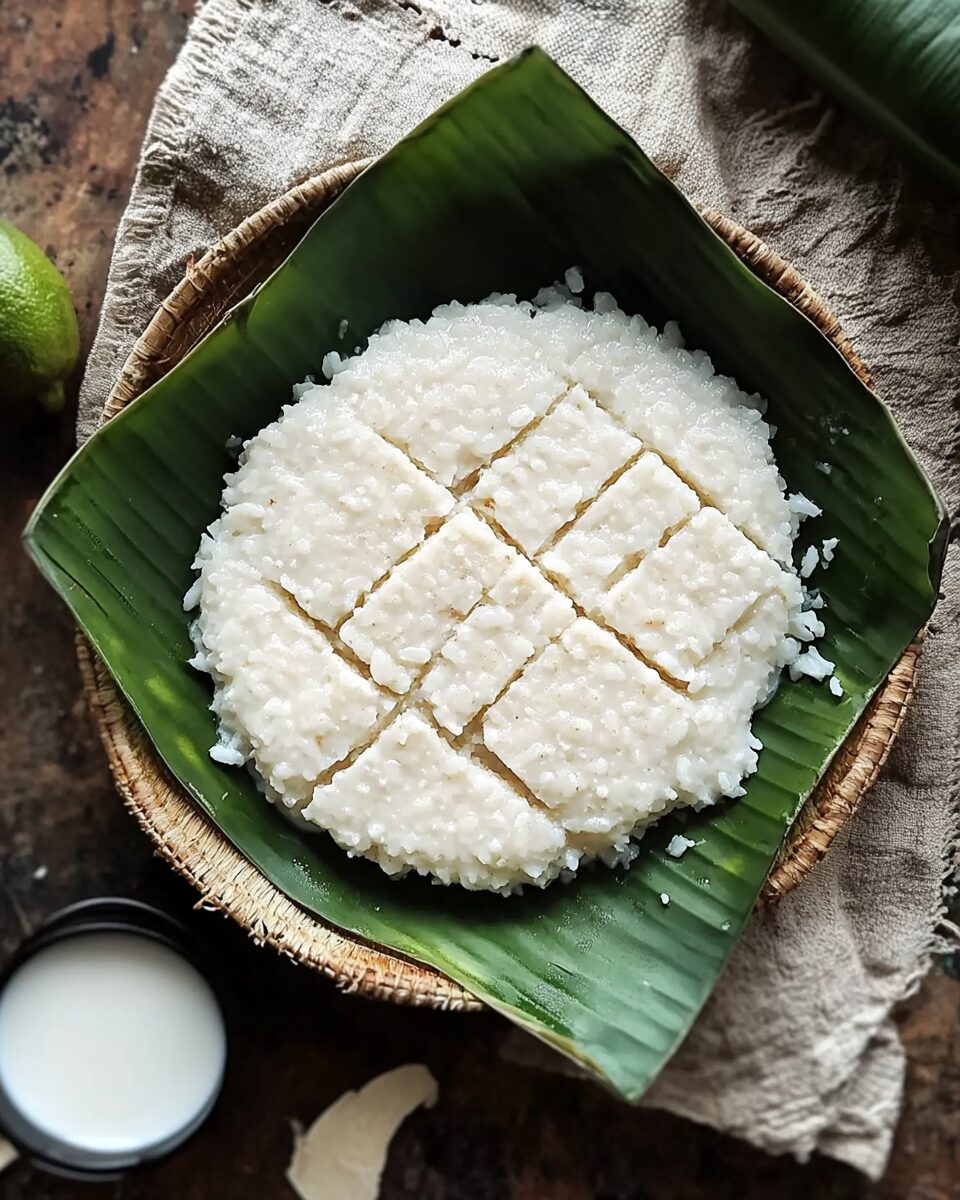Kiribath, or Sri Lankan milk rice, is a cherished national dish traditionally served during celebrations such as birthdays, weddings, and the Sinhala and Tamil New Year. Made with just rice and coconut milk, it symbolizes prosperity and is often enjoyed with both sweet and savory accompaniments. This creamy, comforting dish holds a special place in Sri Lankan households and is typically prepared for breakfast on auspicious occasions.
Full Recipe:
Ingredients
- 2 cups “Kekulu” Rice (or substitute with Basmati or Jasmine rice)
- 3¾ cups Water
- 400 ml Thick Coconut Milk (approximately 1 can)
- 2 teaspoons Salt
Directions
- Cook the Rice:
- Wash the rice thoroughly and drain.
- Place the rice in a rice cooker, instant pot, or a regular pot.
- Add 3¾ cups of water and 1 teaspoon of salt.
- Cook the rice until it’s done but still slightly firm.
- Prepare Coconut Milk Mixture:
- In a separate bowl, mix the thick coconut milk with the remaining 1 teaspoon of salt.
- Taste and adjust the salt as needed; the mixture should be slightly salty.
- Combine Rice and Coconut Milk:
- Once the rice is cooked, immediately add the coconut milk mixture to the hot rice.
- Stir well until the rice grains break down slightly and the mixture becomes sticky.
- If the mixture appears too liquid, cook for an additional 2–3 minutes to evaporate excess moisture.
- Shape the Kiribath:
- Transfer the hot mixture onto a banana leaf or a flat tray.
- Flatten and shape it into a square or round form using a spatula or another piece of banana leaf.
- Allow it to cool slightly to firm up.
- Cut and Serve:
- Once set, cut the Kiribath into squares or diamond shapes.
- For a clean cut, wrap the knife with plastic wrap and apply a bit of coconut milk or water to prevent sticking.
- Serve warm or at room temperature with accompaniments like Lunu Miris (chili onion sambal), Katta Sambal, Seeni Sambal, or ripe bananas.
Nutritional Facts (Per Serving)
- Calories: 255 kcal
- Carbohydrates: 39 g
- Protein: 4 g
- Fat: 9 g
- Saturated Fat: 8 g
- Sodium: 305 mg
- Fiber: 1 g
- Calcium: 16 mg
- Iron: 2 mg
The History of Kiribath
Kiribath has a long-standing history in Sri Lanka, dating back centuries. Historically, it has been prepared for important milestones in life and is a dish that transcends social and religious boundaries. The dish is traditionally associated with prosperity and good fortune, making it an essential component of Sri Lankan New Year celebrations. During the Sinhala and Tamil New Year, it is customary to prepare Kiribath as part of the auspicious rituals, symbolizing the beginning of a new chapter and the wish for wealth and health.
Apart from the New Year, Kiribath is also served during weddings, birthdays, religious ceremonies, and other festive occasions. The dish is often offered to guests as a mark of hospitality and warmth. In fact, many Sri Lankans believe that eating Kiribath will bring good luck and prosperity, especially when it is served alongside savory accompaniments such as chili onion sambal or sweet treats like jaggery.
Cultural Importance of Kiribath
Kiribath is not just a meal but a symbol of unity and tradition. In Sri Lankan culture, food plays an important role in bonding families, communities, and even entire regions. Kiribath is often shared among family members and guests during important events, where the act of serving and eating together enhances the sense of togetherness. The dish is also a significant part of rituals, as it is believed that the first portion of Kiribath, often served by the head of the household, is blessed and holds divine significance.
The preparation of Kiribath often involves the entire family. From washing the rice to mixing the coconut milk, each step is carried out with love and care. This collective effort in the kitchen embodies the essence of Sri Lankan family values – unity, respect, and shared experiences. Whether it’s served on a large platter during a New Year feast or as a comforting breakfast on any given day, Kiribath represents a cultural tradition that continues to be passed down from generation to generation.
How Kiribath is Served
While Kiribath can be enjoyed on its own, it is often paired with a variety of side dishes, depending on the occasion and personal preferences. On festive days, it is commonly served with Lunu Miris (chili onion sambal), a spicy and tangy mixture that provides a contrast to the creamy, mild flavor of the milk rice. Another popular accompaniment is Seeni Sambal, a sweet and spicy onion relish that complements the dish’s richness.
For those with a sweet tooth, Kiribath can also be served with ripe bananas or even sugar and jaggery. The dish can be made into small squares or diamond shapes and served on a banana leaf, which adds an earthy aroma and traditional aesthetic. This presentation of Kiribath is a common sight at celebratory feasts, where the dish is neatly arranged to showcase its delicate texture and inviting appearance.
The Making of Kiribath: A Simple Yet Special Dish
Despite its cultural importance and rich history, the ingredients and preparation process of Kiribath are simple. The main ingredients are rice, coconut milk, and salt. The rice is cooked to a slightly firm consistency, and once cooked, coconut milk is added to the mixture, giving it a smooth and creamy texture. The dish is then shaped into a square or round form and allowed to set.
One of the unique features of Kiribath is its versatility. While the basic recipe remains unchanged, the dish can be customized with various additions depending on regional preferences and dietary restrictions. Some people like to add jaggery to enhance the sweetness, while others prefer a more savory approach by adding spices or herbs. Regardless of how it is prepared, the essence of Kiribath remains the same – a comforting, wholesome dish that brings people together.
Variations of Kiribath
Although Kiribath is typically made with plain rice and coconut milk, there are several regional and personal variations that make this dish even more interesting. For example, in some parts of Sri Lanka, people may add turmeric to the rice, giving it a golden hue and a subtle flavor. In others, a pinch of cinnamon or cardamom is added to infuse the dish with a warming aroma. In coastal regions, where fresh seafood is abundant, Kiribath might be served with fish or other seafood, turning the dish into a more hearty meal.
In addition, some variations involve the use of different types of rice. While traditional Kiribath is made with a short-grain rice called “Kekulu,” some may opt for basmati or jasmine rice for a different texture and fragrance. Although the rice type may vary, the core elements of the dish remain intact – coconut milk and salt.
Health Benefits of Kiribath
While Kiribath is often associated with festive celebrations and indulgent eating, it also offers several health benefits. The primary ingredient, coconut milk, is known for its rich nutritional profile, providing healthy fats, vitamins, and minerals. Coconut milk is an excellent source of medium-chain triglycerides (MCTs), which are easily digestible fats that provide quick energy. These fats have been linked to improved metabolism, better brain function, and enhanced heart health.
Rice, the second main ingredient in Kiribath, is a good source of carbohydrates, which are the body’s primary source of energy. In addition to providing energy, rice also offers essential vitamins and minerals such as thiamine, niacin, and magnesium. When combined with coconut milk, Kiribath becomes a filling and nourishing meal, providing a balance of macronutrients that can sustain you throughout the day.
Moreover, the addition of accompaniments like Lunu Miris or Seeni Sambal adds additional nutritional value. For example, Lunu Miris is typically made with onions, which are rich in antioxidants and anti-inflammatory compounds. Similarly, Seeni Sambal, made from onions and spices, provides a boost of vitamins and minerals.
Kiribath Around the World
While Kiribath is a traditional Sri Lankan dish, it has found its way to the global stage, especially among the Sri Lankan diaspora. In countries with significant Sri Lankan populations, such as the United Kingdom, the United States, Canada, and Australia, Kiribath is prepared for celebrations and special occasions, bringing a taste of home to distant lands. The dish has also become a favorite among people who appreciate traditional, home-cooked meals with rich flavors and cultural significance.
Conclusion
Kiribath is more than just a dish; it is a celebration of culture, family, and tradition. Whether served during special occasions or enjoyed as a comforting breakfast, it embodies the essence of Sri Lankan hospitality and the rich culinary heritage of the island. With its simple yet delicious ingredients, Kiribath continues to be a beloved dish for Sri Lankans at home and abroad.






